Index /
Next
1. Aims of Establishing Long-term Care Insurance
To establish a system which responds to society's major concern about aging, the care problem, whereby citizens can be assured that they will receive care and be supported by society as a whole.
- Lengthening and seriousness of long-term care
One of every two bedridden persons is bedridden for three years or more
- Aging of care attendants
Over 50 % of care attendant are 60 years or over
- Declining percentage of elderly persons living with their children
This has declined to approximately 50%
- Increase in the number of working women
- To build a stable system in which the relationship between benefits and costs is made clear, which can easily gain public understanding
|
äó
üb
üb
üb
üb
üb
üb
üb
äŻ |
ü© |
|
Social support system for long-term care is indispensable
|
|
Efficient delivery of a user-centered, quality long-term care service
- Organize a system so that users can use services of their choice.
- Provide necessary welfare services and health and medical care services in a comprehensive and unified manner, to persons requiring long-term care.
- Promote the participation of a variety of independent enterprises such as people in private enterprise, agricultural cooperatives and citizens' non-profit organizations, and provide service that is not uniform, but diverse and efficient.
Separate long-term care from medical care insurance, and establish a system as a first step towards revising the structure of social security
- Separate long-term care services from medical care insurance, and promote suitable revisions to make medical care and medical treatment oriented.
- Re-examine the inequalities of users costs associated with the separation of welfare for the elderly and medical care services for the elderly, and do away with long-term so called social hospitalization in ordinary hospitals, etc., when long-term care is the overriding need.
- Make elderly persons the policyholders, and have them bear the cost of premiums where possible.
- Introduce a fixed rate 10% charge for long-term care services.
- Currently, such combinations are not covered by medical care insurance.
- Confirm benefit requirements, which are fair nationwide, in accordance with the required care certification standards for benefits.
Future estimation of the bedridden elderly /
the elderly persons suffering from dementia
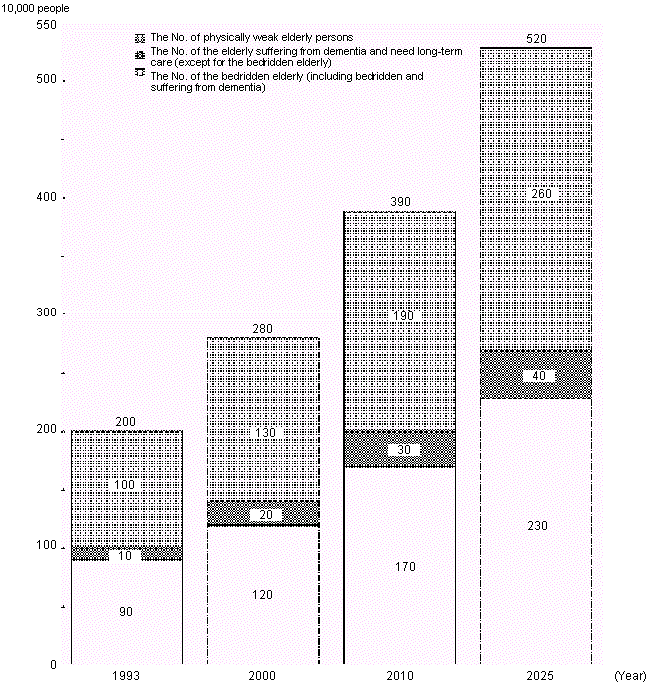
| (Unit: 10,000 people) |
| Category |
1993 |
2000 |
2010 |
2025 |
| Physically weak elderly persons |
100 |
130 |
190 |
260 |
| Suffering from dementia and needs long-term care (except for the bedridden elderly) |
10 |
20 |
30 |
40 |
| Bedridden elderly (including bedridden and suffering from dementia) |
90 |
120 |
170 |
230 |
| Total (elderly needing long-term care etc.) |
200 |
280 |
390 |
520 |
| Population of elderly persons (aged 65 or over) |
1,690 |
2,170 |
2,770 |
3,240 |
|
The percentage of bedridden person by bedridden periods

Care takers for the bedridden elderly
| 1) Breakdown of care takers by their relationship to bedridden persons aged 65 or over |
2) Breakdown of main care takers living with bedridden persons aged 65 or over by age group |
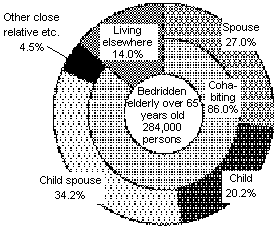 |
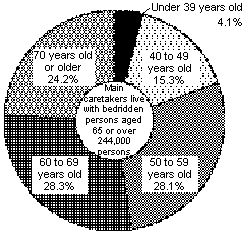 |
3) Breakdown of caretakers of bedridden persons aged 65 or over by sex
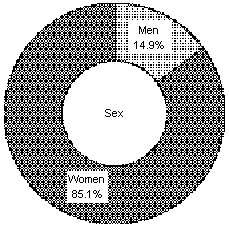 |
3) Breakdown of caretakers of bedridden persons aged 65 or over by sex
 |
"The Comprehensive Survey of the Living Conditions of People on Health and Welfare" by Statistic and Information Division, Minister's Secretariat, the Ministry of Health and Welfare (1995)
Changes in the degree of bedridden of elderly persons
aged 65 or over, by period prior to death
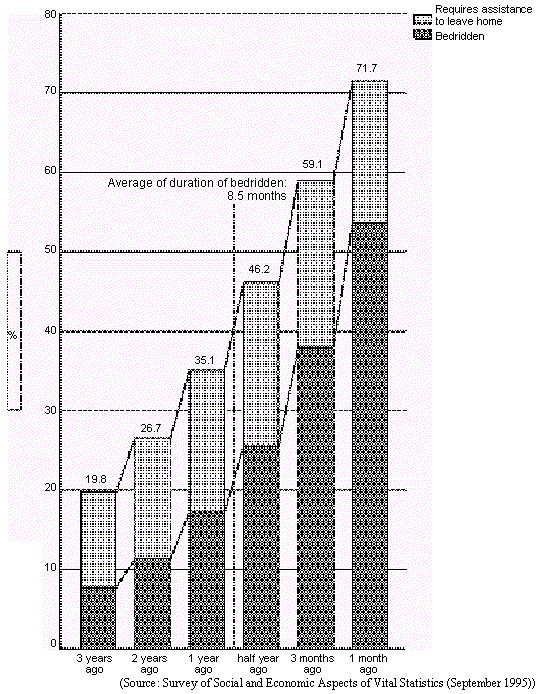
| Requires assistance to leave home |
Lives independently indoors but requires assistance to go out.
| 1) | Goes out with assistance, stays out of bed most of the day |
| 2) | Seldom goes out, has several rests in bed during the day |
|
| Nearly bedridden |
Requires some assistance living indoors and spends most of the day in bed but keep sitting up.
| 1) | Uses a wheelchair to move about, but gets up for meals and to go to the toilet. |
| 2) | Moves about in a wheelchair with assistance. |
|
| Completely bedridden |
Spends all day in bed and requires assistance to urinate/defecate, and with meals and dressing.
| 1) | Can turn over in bed unassisted. |
| 2) | Cannot turn over in bed unassisted. |
|
| Bedridden |
Includes both nearly bedridden and completely bedridden. |
The percentage of persons requiring long-term care in year 2025, and
the percentage of persons who will require long-term care at some stage of life
The situation in year 2025
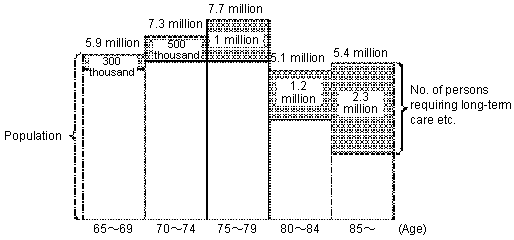
| Percentage of persons requiring long-term care (including bedridden persons who require long-term care) |
1.5% |
3.5% |
6.5% |
11.5% |
24.0% |
| Percentage of persons requiring long-term care including elderly suffering from dementia |
4.0% |
6.5% |
13.0% |
23.0% |
44.5% |
| Percentage of persons requiring long-term care: 5.3 million/32.4 million = |
|
Looking at a person's entire life (aged 65 or over)
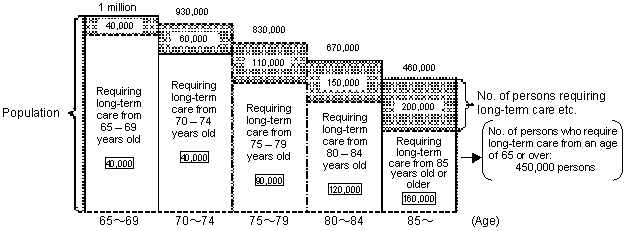
| Percentage of persons requiring long-term care (including bedridden persons who require long-term care) |
1.5% |
3.5% |
6.5% |
11.5% |
24.0% |
| Percentage of persons requiring long-term care including physically weak elderly persons |
4.0% |
6.5% |
13.0% |
23.0% |
44.5% |
Looking at the entire lives of people, approximately 45% will be expected to require long-term care.
Return To Top
Index /
Next









